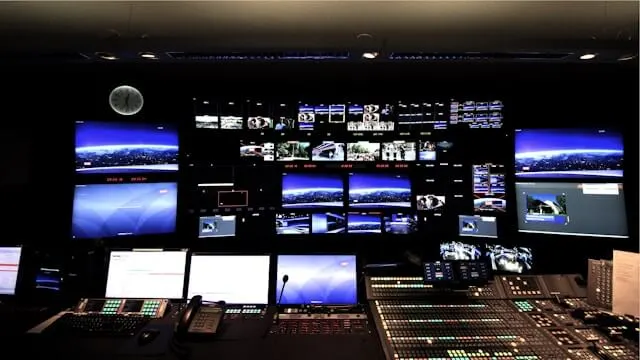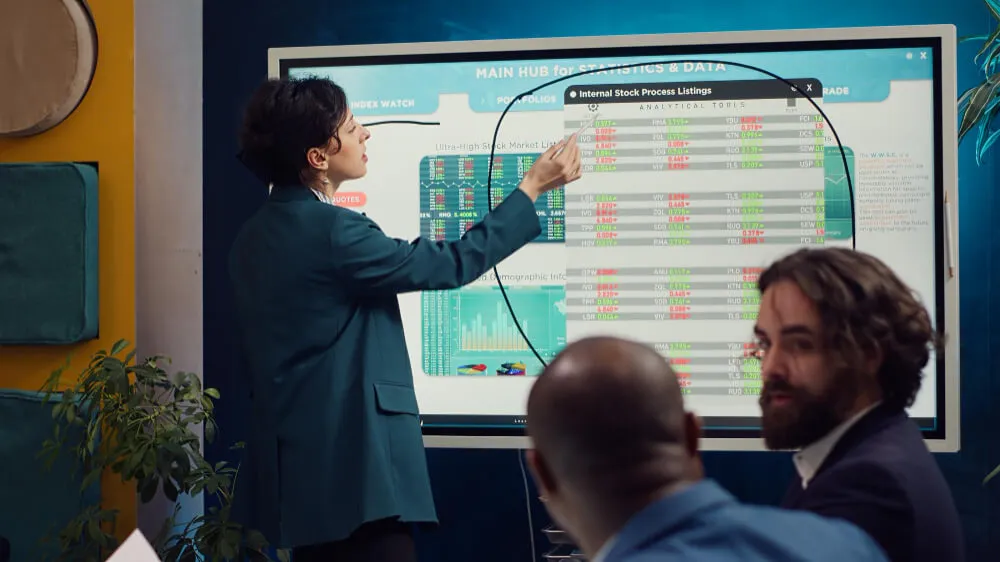24/7 Surveillance: The Nerve Center of Security
LED Video Walls: The future of Command and Control Centers
Eyes on the Network: Seamless NOC & SOC Operations
Introduction: Beyond the Pixels – My Product Managers Perspective
As a lead product manager for video wall software, I see control rooms as the brain of important operations, like emergency services or network management.1 The video wall is key here; it turns a lot of data into one clear picture, helping teams make quick decisions.3 This change from a simple screen to a smart decision-making tool is what excites me most.
Our work goes beyond just the screens themselves. We build the software that connects displays, data, and people. This mix helps operators make fast, smart choices in high-pressure situations. The video wall market is growing fast, expected to hit USD 10.24 billion in 2025 and USD 27.8 billion by 2035.4 This robust momentum and investment are fueled by better screen technology, using internet networks (IP) for connections, and the big impact of Artificial Intelligence (AI).
Video walls are vital for making decisions and understanding situations.3 This means our software isn’t just about showing images; it’s about organizing data, giving context, and helping people react quickly. Our software needs to filter information, arrange displays, and allow smooth interaction, turning raw data into actionable insights. This makes our software a crucial part of operations, requiring us to deeply understand how control rooms work and how people make decisions.
I. Seamless Symphony: The Future of Integration
The Rise of Software-Based Video Walls
I’m observing the market increasingly moving away from proprietary hardware-based video wall controllers, which are often costly, produced in low volumes, and limit future expansion.20 Software-based solutions are gaining significant traction because they ensure new features are delivered through continuous updates, offer greater flexibility, and can be set up without extensive specialized training.13
From a pricing standpoint, this shift is revolutionary. Traditional video wall controllers often rely on specialized, expensive hardware that is produced in low volumes, leading to high costs and limiting future expansion.22 Our software-based approach directly addresses this. By removing the need for much of this costly, dedicated hardware, we can offer solutions that are far more budget-friendly.13 For instance, some software can manage multiple monitors and split screens without needing extra hardware like video wall controllers or KVM switches, simplifying setup and significantly cutting costs.13 Some even offer permanent free versions, making advanced video wall capabilities accessible to a wider range of organizations.13 This makes software-defined video walls not just powerful, but often the most cost-effective type of solution available for many applications.
This trend is crucial for scalability and cost-effectiveness. A software-defined approach allows for on-site upgrades, supporting more displays without needing complete processor replacements.6 It also enables functionalities like automated failover by configuring a second identical PC as a backup 22, significantly improving reliability in mission-critical environments. The shift towards software-defined video walls represents the “democratization of advanced video wall capabilities.” Previously, high-end features were often exclusive to expensive, specialized hardware. Now, with software running on standard IT infrastructure, including powerful PCs or virtualized environments like HyperV and VMWare 13, more organizations can deploy sophisticated video walls with features such as multi-source visualization, interactive control, and automated content management. This expansion opens up new markets and use cases beyond traditional mission-critical centers, driving our product strategy to create more versatile and accessible software.
For a video wall to work well in 2025, it must connect smoothly with all other systems. This means not just linking up, but truly sharing data and controlling everything from one place.
Internet-Based Systems: The Core of Modern Control Rooms
Standard internet networks (IP) are becoming the main way to send video and audio data in control rooms.8 Using “video over IP” makes it easy to show content on any screen—a desktop, the main video wall, or a meeting room display.8 This removes the need for complicated wires and makes systems more reliable.20
From a product development perspective, this means we’re building solutions that are inherently network-aware, leveraging IP protocols for high-throughput, low-latency data transfer.8 Our software must be designed to manage terabytes of data per second without compromising image quality or responsiveness. This development indicates that the network is becoming the new video wall controller. The traditional hardware video wall controller, while still present 6, is increasingly evolving into a software-defined node within a larger IP network. Our software is no longer just managing a single display canvas; it is managing a distributed network of displays and sources. This necessitates robust network management capabilities built directly into the video wall software, shifting control logic from dedicated hardware to intelligent software running on standard IT infrastructure.13 This implies a move towards software-defined video walls that can leverage existing network infrastructure for distribution and control, reducing proprietary hardware dependency and cost.13
Centralized Management: Making Things Simple
Our product development focuses on making user-friendly tools that let operators easily manage content, layouts, and real-time changes.6 This includes quick ways to switch between different views and custom shortcuts.13 This trend means we’re moving towards a “single pane of glass” for all operations. Our goal is to create one interface where operators can control the video wall and also manage all connected systems and data sources directly. This needs strong connections (APIs), good ways to combine data, and a flexible user interface that fits different roles and situations.17 It is about building a complete operational environment, not just a display controller.
Overcoming Connection Problems
A significant challenge I constantly encounter in control rooms is that different systems often don’t work well together, making things difficult and sometimes requiring manual data transfer.16 Old video wall controllers were often custom-made, hard to expand, and could fail completely.20
Our product philosophy is to use open standards and flexible designs to ensure our solutions work with existing systems and many different content sources.6 Our products must work with “any source and any display,” meaning they can take content from anywhere and show it on any screen.6 This includes important links with Video Management Systems (VMS) like Genetec and Milestone, which security operators use daily.20 This highlights the need for “API-first” software design. We build our software with clear connections (APIs) so it can easily link with other systems (like VMS, sensors, communication tools).20 This solves current connection issues and prepares the system for new technologies. Our focus is on what our software can connect to and enable for our customers.
II. The Evolving Canvas: Video Wall Technology in 2025
The way control rooms show information is changing a lot, and we’re building the software to support it. By 2025, we see a clear move towards better display technologies, as everyone wants more data and clearer pictures.
LED Screens Are Taking Over
Direct View LED technology is becoming the top choice for control room video walls. We’re seeing a quick switch to LED displays because they are brighter, more uniform, and have more pixels than older LCD screens.8 This means we can make video walls smaller without losing clarity.8 For our software, this means we need to handle very small pixels (like 0.6mm to 1.2mm) 10 and make sure images look perfect on large, seamless screens.9
Operators often use many 4K monitors, creating their own “mini video walls” at their desks.1 This means our software must manage a lot of data and scale content smoothly, even if the physical screen is smaller.8 We need to build software that can show super high-resolution content (up to 16K UHD) 13 without delays, no matter the screen size or pixel detail. Our goal is software that works with all kinds of content.6
Newer LED tech like MicroLEDs offers amazing brightness, contrast, and lasts a long time.14 For control rooms running 24/7, MicroLEDs use less power and have fewer screen issues, making them a good long-term choice, even if they cost more at first.14 We also focus on eco-friendly tech like Flip-Chip and ColdLED, which save energy and make screens last longer.14 This means our products in 2025 will be judged on performance and how green they are. We need to build software that helps save energy and works with building systems to optimize display use.

The Never-Ending Need for Data
Modern control rooms need huge amounts of high-quality video and strong AV systems.8 Operators are simultaneously monitoring dozens of UHD streams—like security cameras, TV, body camera footage, and web dashboards—and expect clear images.8 This reality has solidified the “more data needs more pixels,” so our networks and video wall controllers must handle massive amounts of data quickly without losing quality.8
This “data overload” is a big problem for operators, who struggle to manage so much information.16 Our software must show the most important information clearly, while keeping other data ready in the background.16 This changes our job from just managing displays to organizing data. We need to build software that can take in, sort, prioritize, and send data from many sources (like security systems, sensors, web feeds) to the right screens (video wall, desk monitor, phone) in real-time.8 This requires strong data systems and smart content management that can handle changing data flows.
III. The Intelligent Core: AIs Transformative Impact
Adding Artificial Intelligence (AI) is completely changing what control room video walls can do, making them smart, active partners in overseeing operations. This is a major area of investment for our product team.
Smart Automation and Event-Driven Actions
A key trend we’re building towards in 2025 is automating video wall actions based on events.8 Our systems are designed to “listen” for triggers—like network alerts, messages, or even a camera failing—and react instantly.8 For example, if a camera stops working, our platform can automatically switch to a backup. In an emergency, it can dim lights, turn on warnings, and show incident footage, all without an operator doing anything.8
Predictive Power: Catching Problems Early
AI is changing control rooms by quickly finding suspicious behavior, unattended items, and crowd patterns, making threat detection automatic.26 AI security systems can react to incidents up to four times faster than old systems, greatly improving response times.26 This includes finding unauthorized access or suspicious actions.26
Beyond security, AI is vital for predicting when equipment might fail. It analyzes trends to suggest repairs before costly breakdowns, making systems more reliable.2 This also includes predicting how things like a typhoon might affect city traffic lights.27 This helps create a “digital twin” of the control room. To truly predict problems, our software builds a real-time model of operations and equipment. AI then uses this model to find unusual behavior, predict failures, and even test different responses. This needs advanced ways to combine data and smart visuals to show complex insights clearly on the video wall.25
AI-Driven Data Harmony and Decision Support
A main challenge I constantly face in control rooms remains how to combine and show large amounts of data from many different systems efficiently.16 AI-driven data analysis is crucial for smart oversight, turning raw, mixed data into easy-to-understand charts and alerts on custom dashboards.2
AI Data Fusion aims to combine company data with AI models in real-time to make AI tools reliable and accurate.33 This involves bringing together, cleaning, improving, and securing data from complex systems.34
Human-AI Teamwork: Helping Operators
I strongly believe AI is here to help human operators, not replace them, by offering tools and clear data.2 Operators are still central to critical decisions.35 Designing user interfaces (HMI) is key to good human-AI teamwork, preventing operators from feeling overwhelmed or losing trust.2
AI-powered Decision Support Systems (DSS) analyze huge amounts of data in real-time, suggest the best actions, and reduce human errors.2 Our smart UIs will adapt layouts and visuals in real-time based on how busy the operator is, reducing distractions and helping them focus.31 Voice commands and other inputs (like touch or gestures) will make tasks smoother and more efficient.31 Operators are open to AI assistants that improve their awareness and reduce stress.35 This highlights the need to “reduce mental load.” Too much data and too many alerts can overwhelm operators.16 Our software must be designed to reduce this mental load, using AI not just to analyze data but to intelligently filter, prioritize, and present only the most important information. Features like adaptive lighting, intelligent climate control 35, and context-aware visualization 31 are not just nice-to-haves; they are crucial parts of an AI-enhanced interface that keeps operators well and helps them make good decisions under pressure. This means smart UI/UX design that uses AI to personalize the operator’s experience.29
Automated Content Management and Personalization
AI and IoT (Internet of Things) are turning video walls from simple displays into “smart digital signs” that can personalize content and adapt to their surroundings in real-time.29 AI can look at how people (or operations in a control room) behave to show specific information, track viewing habits, and adjust content based on live data.29
AI can also schedule content for the best times and collect data on how people interact to improve future content.29 Beyond external applications, in a control room, this means AI can change messages based on who is in the room (e.g., visitors vs. staff), what’s happening in the building, and current company goals.29 This leads to a “self-optimizing display environment.” Our software, powered by AI, can automatically adjust video wall layouts, content priority, and even brightness based on light, temperature, operational needs, and who is in the room.29 This reduces manual work, ensures clear visibility, and makes the displayed information more impactful, turning the video wall into an active part of operations.
IV. My Product Managers Lens: Challenges and Opportunities
While video wall technology, integration, and AI are making big leaps, putting them into critical control rooms brings specific challenges that our product team is actively working on.
Handling Too Much Data and Screen Fatigue
The “flood of data” and the many screens on operator desks are big problems, often leading to “screen overload.”16 Operators struggle to manage and see large amounts of information from different systems, needing to prioritize key data while keeping other information ready.16
From my product management view, this means we need to design easy-to-use interfaces that let operators manage content, switch views, and get background information quickly.6 Our products must offer flexible layout options 6 and real-time changes 24 without overwhelming the user. AI-powered smart interfaces that adapt based on workload can greatly reduce distractions and help operators focus.35 This pushes us towards an “adaptive workspace.” Our software isn’t just a video wall controller; it’s a dynamic environment manager. It should use AI to understand what operators are doing, prioritize information, and automatically adjust the entire display system (main video wall, individual monitors, even lighting and climate 35) to improve performance and reduce tiredness.
The Need for Strong Reliability and Security
Downtime in critical control centers is unacceptable, so strong reliability is key.3 Our systems must be built to last 3 and designed to avoid single points of failure, with flexible designs and automatic backup features.20 Cybersecurity is a top concern, especially with more data coming over networks and more AI integration.2
Our product development focuses on flexible designs, backups 20, and full encryption for all video and data.26 We build in automatic failover 22 and ensure we meet security standards like ISO27001.16 This means “security by design” for AI systems. Since AI handles sensitive control room data, security must be built in from the start. This means encryption, multi-factor authentication, and secure backups at every level of our software.26 AI models also need protection from cyberattacks 2, so our software must be reliable and safe from threats.
Easy to Use and Adapt
Even with advanced features, many video wall controllers can be hard to use and need special training.22 Frequent system changes, like Windows updates, can also disrupt work.16
Our aim in product development is to create powerful but simple solutions with easy controls.6 This includes drag-and-drop features for content 21, interfaces tailored to different roles 24, and possibly voice or gesture control 31 to minimize the learning curve and boost operator efficiency. We want to make advanced features available without needing special programming.6 This highlights the “consumerization of business software.” People expect business tools to be as easy to use as their personal apps. This pushes us, as product managers, to invest heavily in user experience (UX) and user interface (UI) design, adding features like touchscreens 5 and drag-and-drop.20 The challenge is to keep strong features and reliability while making the user experience smooth and almost invisible.
The Way Forward: Growth and Future-Proofing
Video walls are a big investment, so our products must be able to grow with future needs, allowing more inputs or outputs.22 Scalable solutions help organizations add screens easily as their needs grow.3
Conclusion: Shaping the Future of Control Room Intelligence
As 2025 moves forward, I strongly believe the control room video wall is becoming smarter and more connected. LED technology gives us amazing visuals, but it’s the software we develop that truly unlocks its power. The future, as I see it, involves seamless internet-based connections, where the network is the smart core, and central management platforms offer one clear view of operations.
Artificial Intelligence is the real game-changer, turning video walls from simple screens into proactive decision-making tools. AI enables smart automation, gives predictive insights, and manages content dynamically. This change isn’t about replacing human operators but helping them, reducing their mental load, and improving their ability to respond quickly and accurately.
The path ahead has challenges, like managing too much data, ensuring strong security, and designing easy-to-use, adaptable interfaces. But by using software-based solutions, focusing on compatibility, and encouraging human-AI teamwork, our product team is building control rooms that are not just smarter, but also safer, more efficient, and ready for the future. The control room of tomorrow will show the power of smart visuals, driven by innovative software, and shaped by a deep understanding of what people need to operate effectively.




